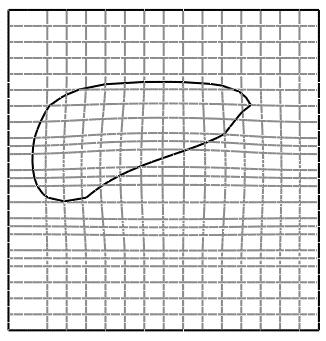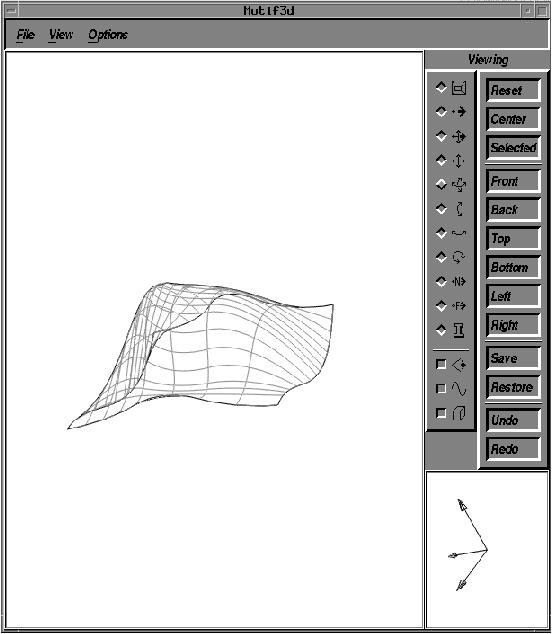


Next: Silhouette Finding Summary
Up: Algorithms for Finding Silhouettes
Previous: Tessellated-Mesh Method
The Srf-Node Method is the most concise. Nodes correspond to
parameter values which are the average of consecutive sets of
(order-1) knots from the knot vector, ignoring the first and last
ones. There are exactly the same number of nodes as there are control
points. It is often convenient to use the nodes when a parameter
value or point on the curve needs to be associated with a control
point [19].
A normal is calculated for every node point on a surface, as shown in Figure 4.4(b). This
calculation can be done as a preprocess and only has to be done once
per surface.
Then, E(u,v) . n(u,v) is calculated for every view and every
node point, where n(u,v) is the surface normal at the node point and
E(u,v) is the vector from the eye to the point on the surface. The
resulting signs of the dot products,  , are stored in a
table, one per node point, as shown in
Figure 4.8. If
, are stored in a
table, one per node point, as shown in
Figure 4.8. If  is zero then
there is a silhouette at that node point on the surface. By searching
the table in the u direction and then in the v direction, a silhouette
can be found by comparing
is zero then
there is a silhouette at that node point on the surface. By searching
the table in the u direction and then in the v direction, a silhouette
can be found by comparing  to
to  i+1, j and
i+1, j and
 to
to  i, j+1 , respectively. If a sign changes
from + to - or from - to +, then there is a silhouette between those
two points on the surface, as shown in
Figure 4.4(b).
i, j+1 , respectively. If a sign changes
from + to - or from - to +, then there is a silhouette between those
two points on the surface, as shown in
Figure 4.4(b).

|
Figure 4.8:
Visualize the Srf-Node Method as a table of signs
 , where can be +, -, or 0. , where can be +, -, or 0.
|
When a region containing a silhouette point is found between two node
points, it is linearly interpolated, as shown in
Figure 4.1. The interpolation is based on two
surface points and the respective angles formed by the normal and the
eye vector, calculated as in Equation 4.1
and 4.1 and as discussed in Section 4.1.2.1.

|
| Figure 4.9: Srf-Node Method can result in missed silhouettes depending
upon the node points. If for example, the node points were those that
correspond to theta_1, theta_2,and theta_3, there would be three
missed silhouette points because theta_1, theta_2,and
theta_3, are all less than 90 degrees and there would be no sign
change. However, if the nodes points were alpha, theta_2,and
theta_3, then alpha is greater than 90 degrees and theta_2 is
less than 90 degrees, so the silhouette between the two corresponding
node points would not be missed and could be interpolated. The
problem of missing these silhouettes can be remedied by refining the
control mesh.
|
In order for this method to work, the surface has to be sufficiently
refined or it may miss silhouettes, as discussed in
Figure 4.9. Surface refinement only needs to be done
once and can be done as a preprocess over the whole surface. However,
the refinement increases the number of control points and thus the
number of checks necessary to locate the silhouette points. It may be
better to refine the area where a silhouette may be, based on testing
the control mesh.
Using a 2D marching-cube data structure makes it easy to connect the
silhouette points to form linear silhouette
curves. Figure 4.5(b) provides a
visualization of the  and the approximate silhouette
lines. This method results in edge lines as displayed in
Figure 4.10. Another exaple is shown in the top down view shown in
Figure 4.11 and the
view from the eye point in
Figure 4.12.
and the approximate silhouette
lines. This method results in edge lines as displayed in
Figure 4.10. Another exaple is shown in the top down view shown in
Figure 4.11 and the
view from the eye point in
Figure 4.12.
 |

|
| View of surface with silhouettes and surface
boundaries generated with Srf-Node Method.
|
Looking down on
surface with silhouettes and surface boundaries.
|
| Figure 4.10: Srf-Node Method.
|

|
| Figure 4.11:
Looking down on surface with silhouette generated with
Srf-Node method. Compare this image with the 2D projection and
approximation of silhouettes shown in
Figure 4.5 using the Mesh method
and the Srf-Node method.
|

|
| Figure 4.12:
View of the same surface represented in
Figure 4.5, 4.4,
and 4.11 with
silhouettes generated with the Srf-Node method.
|



Next: Silhouette Finding Summary
Up: Algorithms for Finding Silhouettes
Previous: Tessellated-Mesh Method
 , are stored in a
table, one per node point, as shown in
Figure 4.8. If
, are stored in a
table, one per node point, as shown in
Figure 4.8. If  is zero then
there is a silhouette at that node point on the surface. By searching
the table in the u direction and then in the v direction, a silhouette
can be found by comparing
is zero then
there is a silhouette at that node point on the surface. By searching
the table in the u direction and then in the v direction, a silhouette
can be found by comparing  to
to  i+1, j and
i+1, j and
 to
to  i, j+1 , respectively. If a sign changes
from + to - or from - to +, then there is a silhouette between those
two points on the surface, as shown in
Figure 4.4(b).
i, j+1 , respectively. If a sign changes
from + to - or from - to +, then there is a silhouette between those
two points on the surface, as shown in
Figure 4.4(b).





